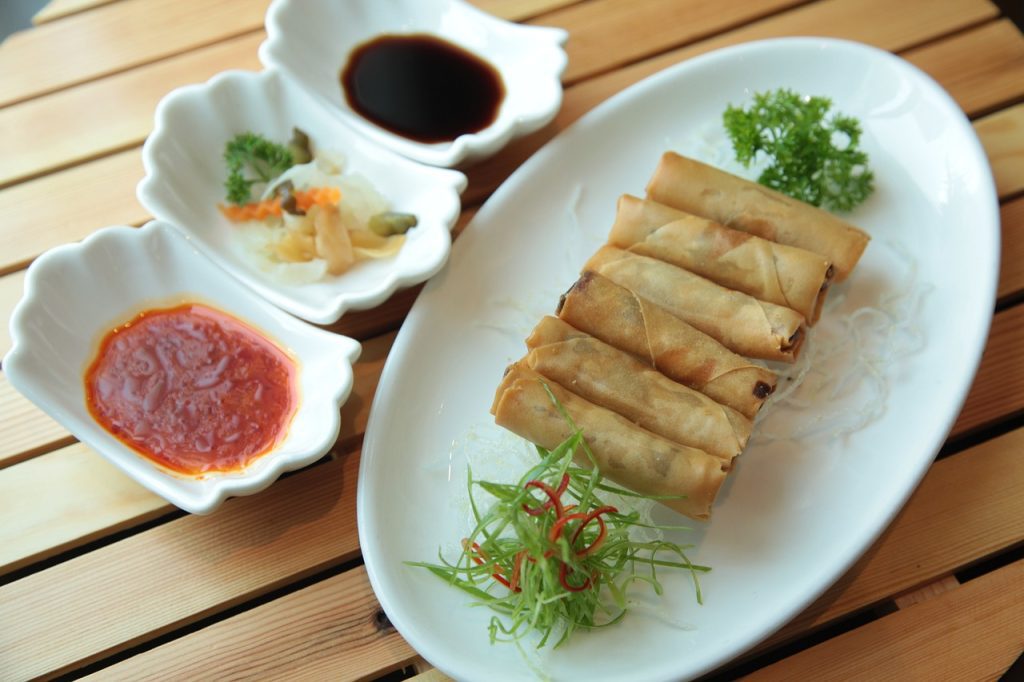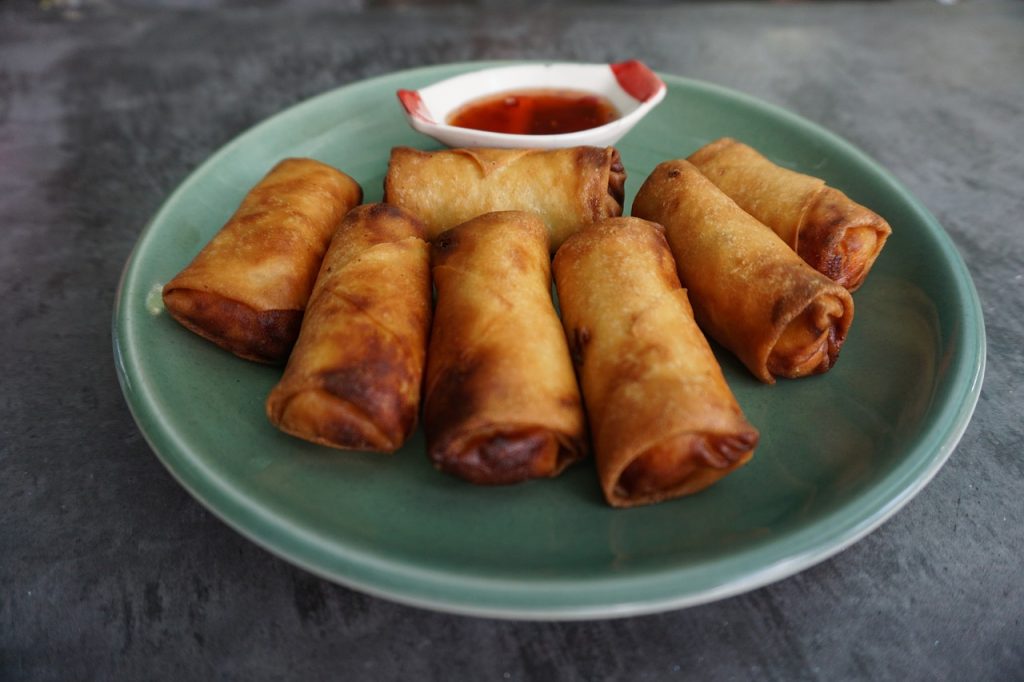Learn about How to Make Vegetable Spring Rolls at Home. Learn how to make vegetable spring rolls at home with this easy guide. Fresh or fried, these rolls are packed with veggies and flavor, perfect for a tasty, homemade snack.
Introduction
Rolls are a broad category of foods (that is) comprising ingredients wrapped in a shell or covering. In different forms, such as bread rolls, sushi rolls, and spring rolls. Bread rolls are usually baked in the oven and are used as a sandwich base or a side dish. Sushi rolls hence Maki contain seasoned rice with other fillings like fish or vegetables covered with seaweed.
Spring rolls on the other hand are made using thin skins to wrap ingredients such as meat and vegetables which can be either fried or served fresh. Every type of roll provides a unique taste and feel that suits various cuisines hence they are common in many countries.
What are Vegetable Spring Rolls?
Vegetable Spring rolls are celebrated for their freshness. It has a crispy or fresh wrapping containing several kinds of pieces. Made from rice papers or wheat paste, they contain contents including; cabbages, carrots mushrooms, and bean sprouts. They can be eaten like snacks when fried to become crunchy or when they are fresh with sauces like hoisin, peanut, or sweet chili served together.

These are the most flexible rules as they allow you to use different regions’ diverse cuisines at will and convenience. They make for a great light meal for any sort of day with nutritional value in them for everyone in the family.
Ingredients in Vegetable Spring Rolls
- Vegetables: The usual options are carrots, bell peppers, cabbage, and bean sprouts. Additional flavors and textures can be created using zucchini, spinach, or mushrooms.
- Wrapper: Fresh rolls often use rice paper, but fried rolls often employ wheat flour wrappers. Probably both should be easily found in most grocery stores and Asian markets.
- Seasonings: The filling flavor is augmented by such ingredients as soy sauce, garlic, ginger, and a dash of salt. To bring about freshness either cilantro or mint among the fresh herbs can be used.
- Dipping Sauce: Serve with sauces like hoisin, peanut, or sweet chili sauce for an extra taste. In some dumping recipes, you will also find soy sauce-based dipping sauce.
- Optional Additions: You might also want to include tofu, and tempeh or sprinkle some sesame seeds for added flavor.
How to Make Vegetable Spring Rolls at Home
1. Prepare the Vegetables
Thinly chop vegetables like carrots, bell peppers, or cabbages. Also, there is an option of incorporating mushrooms and bean sprouts. With a little oil in a pan, stir-fry them briefly until tender. Finally, sprinkle soy sauce for seasoning as you add a little salt for taste.
2. Soften the Wrappers
If you are using rice paper, soak it in warm water for a while just to soften it. Do not soak it too much because it can break easily. Afterward, place the softened sheet on a clean surface or wet cloth.
3. Assemble the Rolls
Place a small amount of the cooked vegetables onto the wrapper, leaving space around the edges. Fold over the sides to enclose the filling, then roll the roll tightly from the bottom up. The rolls must be snug but not too tight.
4. Cook or Serve
In case of fresh rolls, serve immediately with a dip such as hoisin or peanut sauce. As for crisper rolls, heat oil in a pan then fry till golden brown. Remove using paper towels for drying up grease then serve hot.
5. Enjoy
Serve with your favorite dipping sauces and enjoy your freshly made vegetable spring rolls!
6 varieties of Spring Roll from around the world that people love to eat
1. Chinese Spring Rolls
These are shallow fried thin cylinders containing within them mixtures of either vegetables, meats or seafood served along with sweet and sour sauce for dipping. They represent the perfect example of how creative one can be with Chinese food, especially during the Lunar New Year.
2. Vietnamese Goi Cuon (Summer Rolls)
Rice papers are thin and make it possible to prepare light rolls filled with veggies, herbs, and occasionally prawns or pork. They’re presented in a cold form, usually accompanied by dipping sauces like hoisin or peanut which gives them an inviting taste.
3. Thai Popiah Sod
Thai fresh spring rolls use rice paper as wrappers while being stuffed with an assortment of fresh veggies, herbs, and at times either tofu or shrimp. Such rolls are conventionally accompanied by some hot and spicy chilli sauce thereby giving an explosion on one’s taste buds.
4. Filipino Lumpia
Lumpia are Filipino spring rolls that are of two main types; fresh (lumpiang sariwa) and fried (lumpiang shanghai). They usually have different combinations of vegetables and meat, with a garlic-peanut sauce or vinegar dipping sauce as an accompaniment.
5. Indonesian Risoles
They are called Indonesian spring rolls and have a crispy outer layer and savory filling which is made from minced meat, vegetables, and sometimes cheese. They are normally served as snacks or starters and frequently accompanied with hot chili sauce.
6. Japanese Harumaki
Harumaki are Japanese spring rolls that are similar to Chinese ones although they frequently contain elements like cabbage, pork, or shitake mushrooms. They are deep-fried until they turn golden and are usually served with soy sauce or tangy dip
Pros and Cons of Vegetable Spring Rolls
1. Pros
- Healthy: Vegetable spring rolls are filled with a variety of fresh vegetables that your body needs to achieve adequate intake of vitamins, minerals, and fiber. Its low-calorie content makes it an ideal snack or meal for weight loss since it meets your everyday vegetable requirements without too much effort.
- Versatile: Vegetable spring rolls can be adjusted to suit your choice of vegetables and herbs, and you can even include tofu to add protein. The dipping sauces like peanut or hoisin introduce another flavor option. These features make them an attractive choice to fit in different tastes and diets, whether vegan or omnivorous.
- Light: Vegetable spring rolls are great for a quick meal or an appetizer. They deliver enough flavor without leaving one too full. If fresh or fried, they can go well with other foods or stand-alone without making one feel heavy.
- Fresh or Fried: If you want to eat vegetable spring rolls, you can have them boiled or fried depending on your taste. While fresh is light and crispy with raw vegetables, the fried ones taste delicious because they are juicy inside and crispy outside and able to suit multiple occasions.

2. Cons
- Preparation Time: It could be time-consuming just to prepare vegetable spring rolls. These rolls need an individual to chop all the vegetables and then patiently assemble them as well as roll each one of them carefully because it is a process that requires much focus and concentration. As such, this makes them only good for those days when you have all the time in the world such as weekends.
- Fragility: Rice paper, which is commonly used as a wrapper for vegetables in spring rolls, is very fragile and may tear while assembling. This can be quite challenging for newbies or those not used to the leaf, frustrating the person and the product may not look as clean as expected.
- Storage: If not stored properly, fresh vegetable spring rolls dry quickly, which in turn messes with its texture. On the other side, fried spring rolls tend not to be as crispy as before after reheating them thus making them less enjoyable for they are best eaten immediately after preparation.
FAQs
Are vegetable spring rolls healthy?
Indeed, vegetable spring rolls are healthier; and have fewer calories as well as abundant vitamin and fiber content from the vegetables. Choosing to forgo fried versions for fresh rolls makes them more nutritious thereby offering a lighter meal option.
Can vegetable spring rolls be made without gluten?
Vegetable spring rolls may easily be modified into a gluten-free recipe. Wrap them in rice paper only and make sure every single element including sauces does not contain any gluten. Most dipping sauces have other varieties without it.
What is the best way to reheat vegetable spring rolls?
To heat vegetable spring rolls, you can simply bake them in the oven at 375°F (190°C) for nearly 10 minutes to regain their crispiness. You should not use a microwave since this only leads to soggy wraps.
What are some common mistakes to avoid when making vegetable spring rolls?
Frequent errors during preparation include leaving the rice paper in water for too long, resulting in mushy sheets that easily tear; filling it too lightly will make it hard to seal up your rolls. Do not put too much stuffing to ease rolling and achieve proper cooking.
Conclusion
A widely appreciated, pliable, and tasty dish is vegetable spring rolls. They offer a healthful and fulfilling possibility for a meal because they have a crispy or fresh covering alongside colorful vegetable contents. For individuals who like them crispy, people can also opt to have them raw while sharing them with different dipping kinds, making it a fun experience to use seasonal products in vegetable spring rolls. For any event and very simple to prepare in your kitchen, now this is the one that has been noted best in terms of balancing the flavors and nutritional composition required by the human body.
